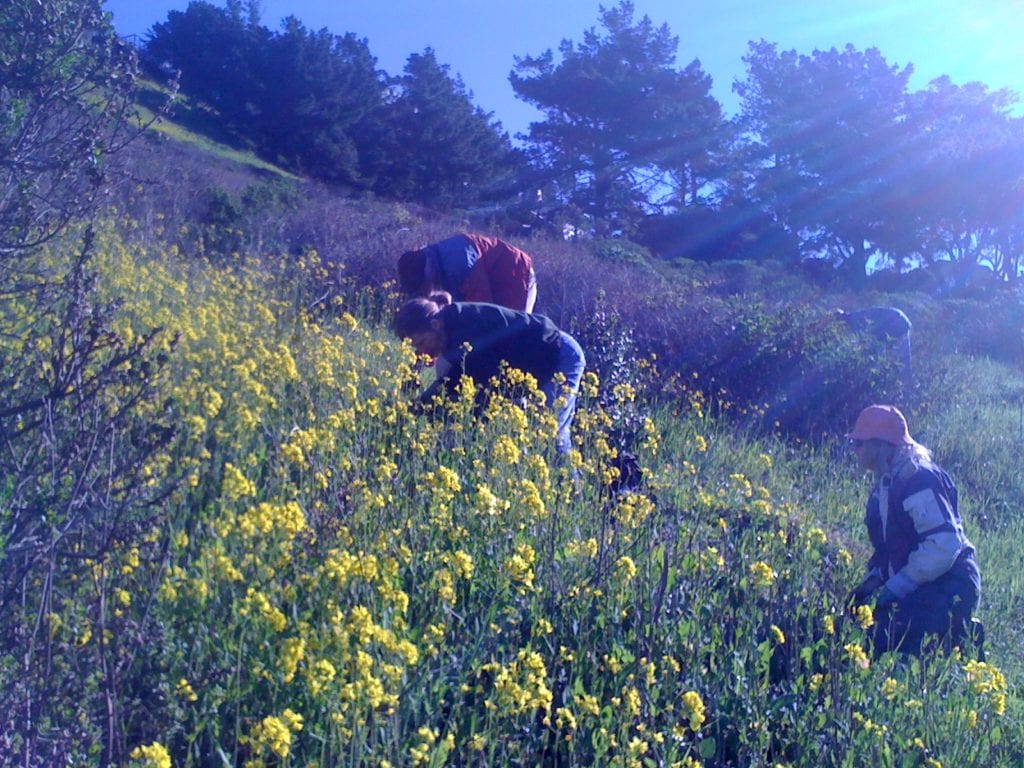
Story and photos by Murray Schneider
Intermittent April shower brought with them a profusion of mustard, which blanketed swaths of Glen Canyon’s eastern hillside on a recent Wednesday. Bunched in the shadow of Diamond Heights homes, the invasive ground cover could easily have doubled for colorful daisies.
On April 9, eight Friends of Glen Canyon Park volunteers joined a team Rec and Parks Natural Areas Program gardeners and interns and spent the morning uprooting the invasive weed, whose origin harkens back to the Mediterranean.
The strands were easy to pull up as the rains had softened the earth. Above, a homeowner standing on his deck watched their progress as they twisted between clumps of low-lying coyote brush. Each made a studied attempt to avoid poison oak, marbled red, green and glossy, among the shrubs.
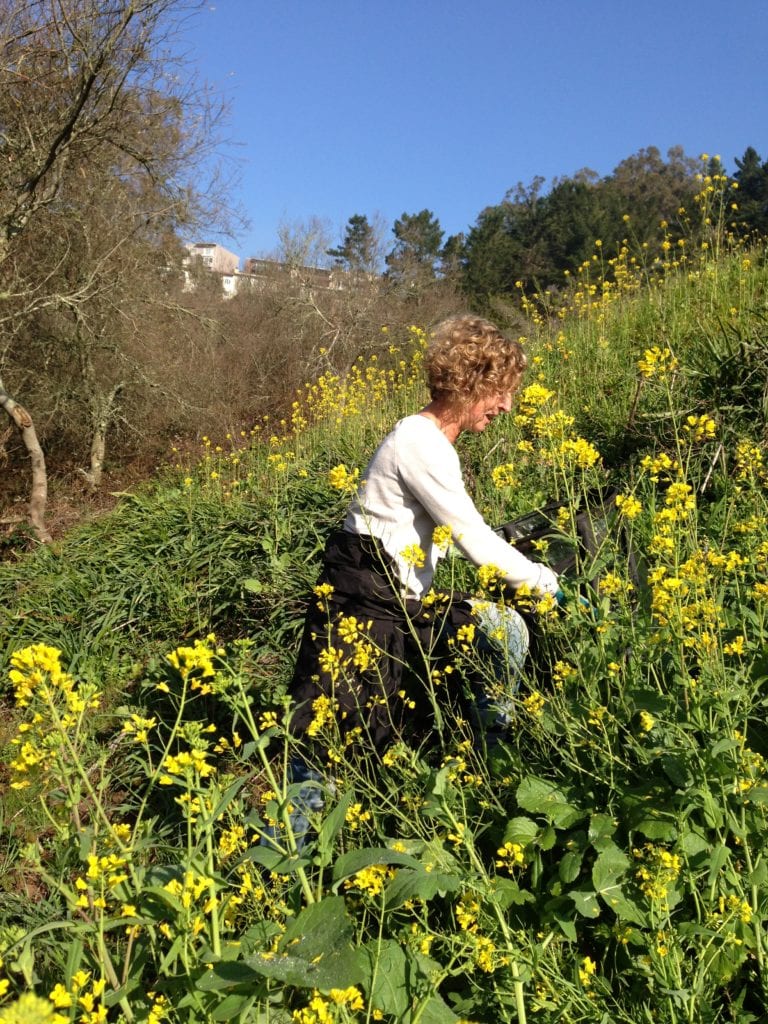
Sparrows sang among branches closer to backyards while the NAP gardener explained to the homeowner that quilts of mustard, while deceptively pleasant to the eye, behave as inimical intruders, smothering and camouflaging the commissaries of canyon raptors and mammals.
The volunteers found nothing new in this message. Each was a veteran of NAP work parties. Each was familiar with the Natural Area Program’s mission, which is to restore and enhance 32 San Francisco natural areas while developing and supporting community stewardship of these sites.
Glen Canyon’s 70-acres is a prime candidate for such habitat management.
The homeowner pointed in the distance to where he’d routinely observe coyotes denning. While he and the gardener talked, others added mustard to blue tarps already weighted down with stalks. The pile waited removal to Radish Hill, a mound of earth carpeted with colonizing radish. The hummock hulks over an Indian file hiking trail that threads its way along a steep canyon precipice.
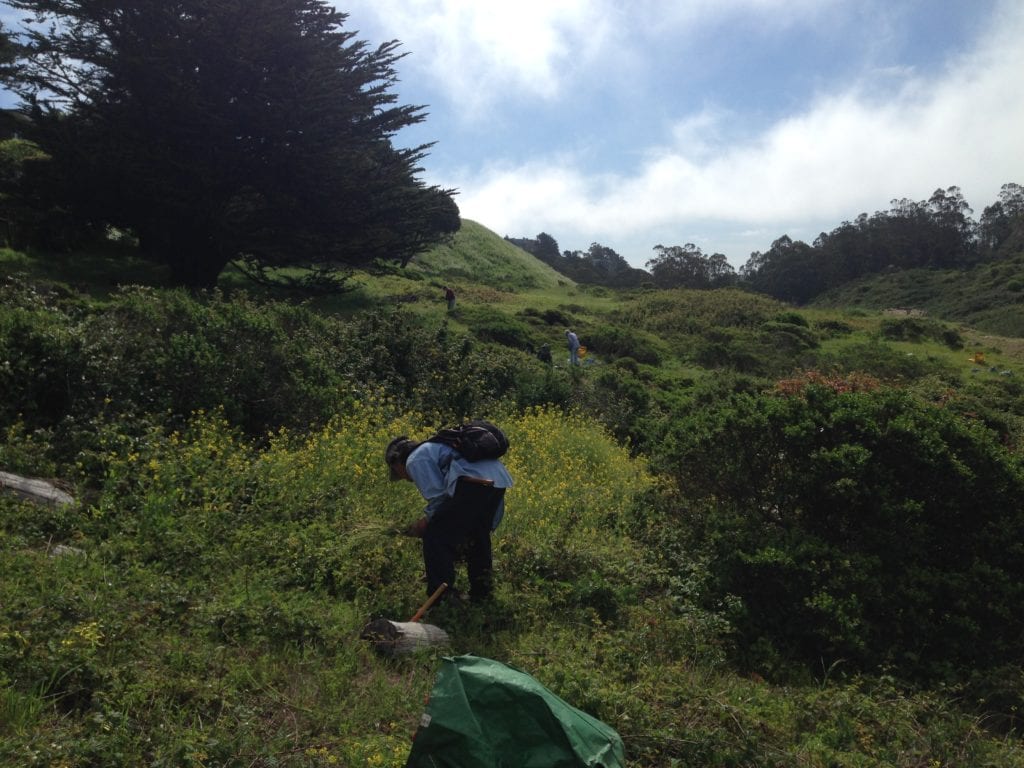
Farther to the south, a group of school children on an outing huddled together on chert outcroppings. They towered above the Saddle Trail, recently improved with both box and stringer steps. Several dog walkers skirted the children on the way to steps that would return them to the canyon’s floor.
Another NAP gardener shouldered a mustard-filled tarp and he eased his way along a narrow path leading to Radish Hill. The mound was first placed in Glen Canyon when contractors, who built Diamond Heights in the late 1950s, unceremoniously dumped truckloads of excavated earth onto the canyon hillside. The dumpsite has been home to intruding radish ever since.
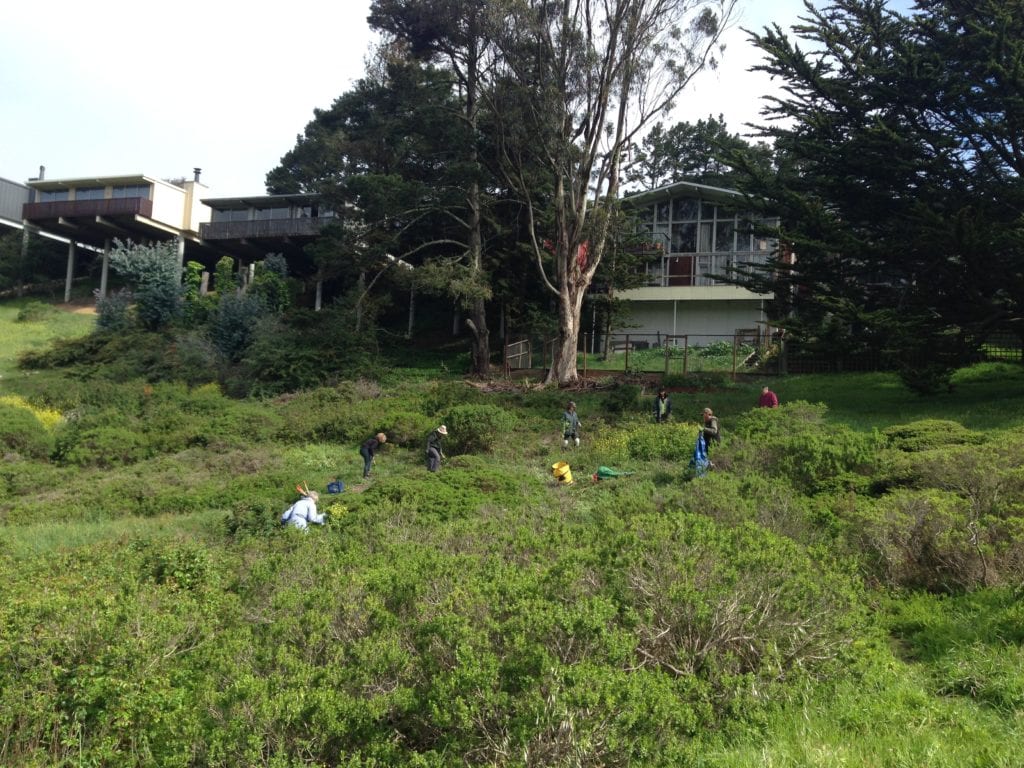
Bearded and dressed in mud-stained denim work pants, the gardener made several trips back and forth to Radish Hill, silhouetted by homes on the other side of O’Shaughnessy Boulevard. The houses stood on a cul-du-sac. In the late 1930s this spit of land was once part of the highest reaches of Glen Canyon. Civil engineers blasted rock formations to prepare it for construction, as they’d earlier done for O’Shaughnessy Boulevard itself. It was then that El Sereno Court, isolated on its wind swept promontory some 800 feet above Glen Park and less than a mile from Mt. Davidson, was made ready for pre-World War II homebuyers.
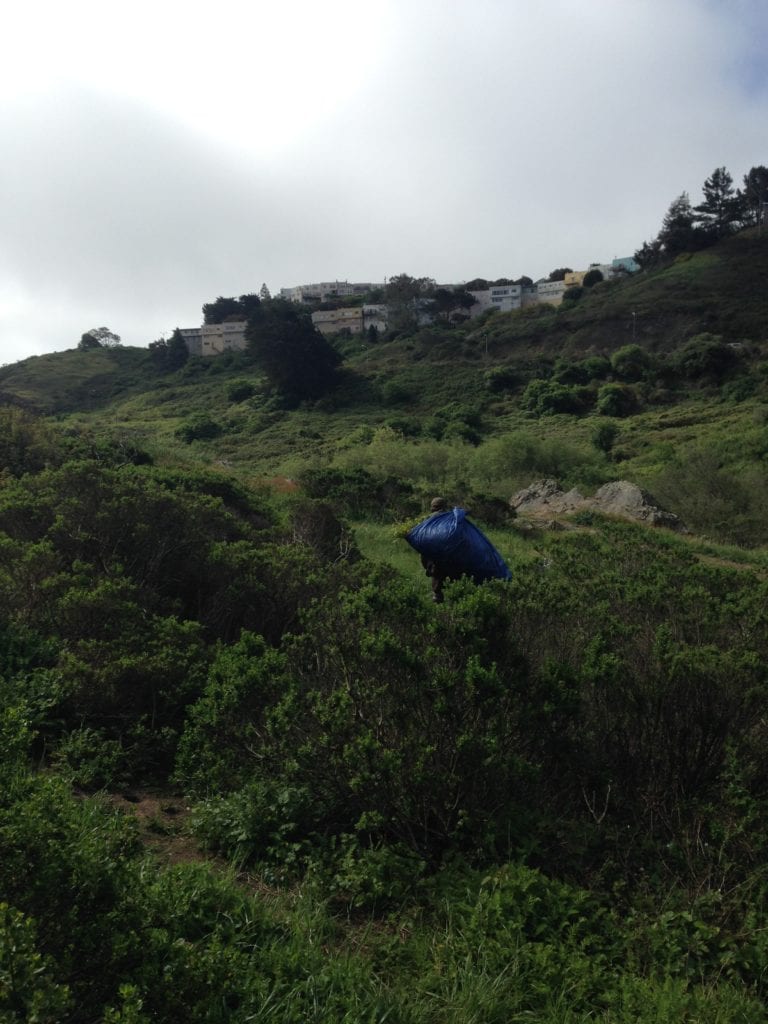
With the mustard removed, the volunteers turned their attention to radish. Removing it, they let it rest where it lay. When finished for the morning, they gathered up their tools and yellow pop up bags and made their way to Turquoise Way where a Rec and Parks truck waited. They placed mattocks, tarps and bags in the truck’s flat bed.
A City gardener told them not to fold up their gloves, as she planned to have them washed because of their proximity to poison oak. Anyone who was interested in washing their hands grabbed packets of Tecnu, which they used to swab their arms and hands to cleanse them of poison oak oils.
A volunteer had driven to the site and offered rides back to Glen Park. Declining, Steve Uchida and Jim Hanratty decided to retrace their earlier steps, winding their way back through the canyon.
They weren’t that far from where Rec and Parks plans to construct a “connector” trail that will switchback through San Francisco Unified School District property on the School of the Arts campus.
The “Creeks to Peaks” trail will take walkers from Elk Street, through the canyon, across Portola Drive and upward to Twin Peaks.
Arroyo willow trailed along side Uchida and Hanratty as they walked downhill. Willow, a variable soft wood species, is common along stream banks. It grows upright into a shrub or small tree. Islais Creek would certainly qualify, and it now gently gurgled as Uchida and Hanratty wove their way downward.

Once it matures, gaining height and weight, willow may bend or break until it touches the ground, which is what happened on the west side of the creek just north of Silver Tree Camp. The contorted limbs had reclined horizontally, obstructing Willow Loop Trail, and only recently NAP arborists had pruned the bulbous branches, facilitating easier access along the path and relieving hikers from having to pretzel beneath it.
Uchida and Hanratty reached Glenridge nursery school and continued on a path its children have for decades called Banana Slug Way. The trail parallels Alms Road on the eastern side of Islais Creek.
At mid-point, the trail overlooked the creek. A rickety, single timbered log functions as a makeshift barrier. It wouldn’t prevent someone slipping beneath it and tumbling into the stream. It’s scheduled for removal and upgrade during the continuing 15-month Glen Canyon Trails Project.
Continuing on, the two men reached the WPA-built Recreation Center, now surrounded on its northern backside with freshly planted grass and on its south side with state-of-the-art children’s playground apparatus, recently inaugurated at a March 15 public ceremony.
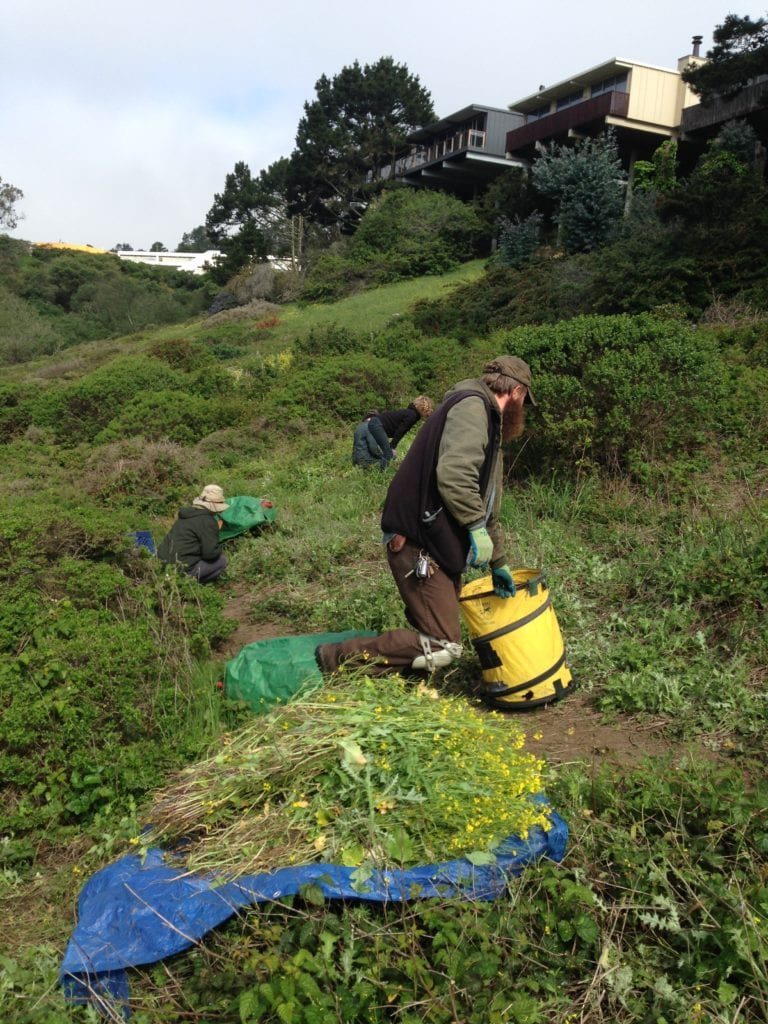
Here they exchanged goodbyes; Uchida heading for his Monterey Boulevard home, Hanratty for his Stillings Avenue house. They’d rendezvous the following Wednesday, scheduled for another weekly work party that could have them again removing mustard and radish.
The two had completed the short walk from Turquoise Way mostly in silence, maybe a mile or more, each privy to his own thoughts. Glen Canyon belongs to us all, no more to one to than another. Their trusteeship, tending and caring for it entitled them to no special claims. But their shared stewardship of this land more than likely gave each a special fraternity with it and with each other.
Those who would like to join Friends of Glen Canyon Park volunteers on either Wednesday or Saturday, you can call Jean Conner at 584-8576. Volunteers are also welcome to call the Natural Areas Program. Contact David Burnet at 871-0203 or email david.burnet@sfgov.org.